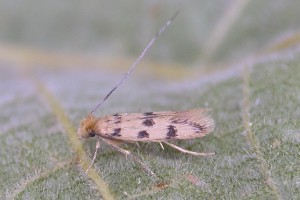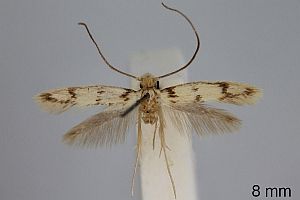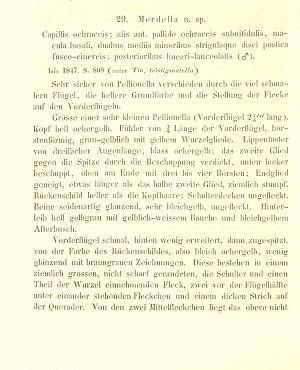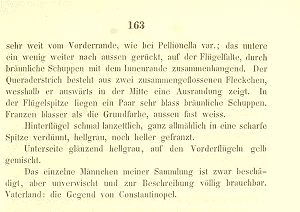

 +17Kontinente:EUASAF
+17Kontinente:EUASAF2. Diagnose
2.1. Männchen
2.2. Erstbeschreibung
2.3. Beschreibung als Tineola quadruplella
3. Weitere Informationen
3.1. Andere Kombinationen
- Tinea merdella Zeller, 1847 [Originalkombination]
- Paratinea merdella (Zeller, 1847)
3.2. Synonyme
- Monopis siccanella Chrétien, 1915
- Tineola quadruplella Caradja, 1920 [synonymisiert durch Gaedike (2019: 248-249)]
- Paratinea quadruplella (Caradja, 1920)
- Proterospastis quadruplella (Caradja, 1920) [K+R.-Nr. neu: 00693a]
- Tinea palaestinella Amsel, 1935
3.3. Taxonomie
Das Taxon Tineola quadruplella wurde nach einem Einzeltier beschrieben. Caradja (1920: 171) vermerkte dazu: "Ein ♂ von Granada bildet die Type in meiner Sammlung". Dieses Taxon - Tineola quadruplella Caradja, 1920 - war seit Langem umstritten. Auch Gaedike (2004: 80) wies auf den zweifelhaften taxonomischen Status hin: es handele sich sehr wahrscheinlich um ein Synonym. Gaedike (2019: 76-77) nimmt dann die überfällige Synonymisierung auch formal vor und schreibt dazu: "In the past it was impossible to clarify the exact taxonomic place and status of Tineola quadruplella Caradja, 1920. Petersen (1957a: 163), according to the description, transferred it into the genus Paratinea and he presumed, that it could be a synonym of P. merdella or P. autochthones. In reply to my request for the loan of the holotype (♂), Mr. Stanescu, custodian in the Museum Bucuresti, the Location of the Caradja collection, informed me, that "... there is no type specimen or any specimen designed as quadruplella ..." in the collection." Vor diesem überraschenden Hintergrund kam Gaedike (2019: 77) zum Schluss: "According to the original description and under consideration of the known distribution it seems justified to put Tineola quadruplella Caradja, 1920 as a synonym of Proterospastis merdella (Zeller, 1852)."
3.4. Faunistik
Das hier als Synonym aufgefasste Taxon Tineola quadruplella wurde nach einem Einzeltier aus Granada (Spanien) beschrieben, weshalb Proterospastis quadruplella in der Fauna Europaea für Spanien angeführt wird. Zur Gesamtverbreitung der P. merdella teilt Gaedike (2019: 77) mit: "Canary Islands, Iberian Peninsula, Malta, Italy: Sicily, Croatia, Greece (Islands of Aegina, Samos, Crete), Cyprus, outside Europe in Algeria, Libya, Egypt and Turkey." Die Art ist im Mittelmeerraum also weit verbreitet, auch wenn sie selten gefunden wird.
Grange et al. (2023: 184) melden die Art als neu für Frankreich und berichten über eine Reihe zuvor fehlbestimmter Tiere aus der Innenstadt von La Ciotat (Bouches-du-Rhône) am Mittelmeer (2007, 2013 und 2014) und einem Exemplar von Jujols, 850 m, aus den Pyrénées-Orientales.
Bassi (2024: 96) kann über eine große Serie von Faltern auf Sardinien berichten: "37 ♂♂♀♀, Sardegna, Olbia, Porto Rotondo, 26.VI-2.VII. 2011, 23-28.VI.2014, 1-3.VII.2015, 27 29.VI.2017, 29.VI-4.VII.2020, 28.VI-5.VII.2021, 27-29.VI.2023, genitalia slides 20590 e 20652 Bassi, G. Bassi legit, G. Bassi e J. Nel det. Collezione G. Bassi, 1♂, Sardegna (SU), Nebida, 4.VII.2001, G. Bassi legit, J. Nel det., Collezione G. Bassi."
(Autor: Erwin Rennwald)
3.5. Literatur
- Bassi, G. (2024): Segnalazioni faunistiche Italiane. — Bollettino della Società entomologica italiana, 156 (2): 95-96.
- Beschreibung als Tineola quadruplella: Caradja, A. (1920): Beitrag zur Kenntnis der geographischen Verbreitung der Mikrolepidopteren des palaearktischen Faunengebietes nebst Beschreibung neuer Formen. III. Teil. — Deutsche Entomologische Zeitschrift Iris 34 (1/2): 75-179. Dresden.
- Gaedike, R. (2004): Bemerkungen zu einigen wenig bekannten Tineidae in Europa (Lepidoptera). — Acta entomologica slocenica 12 (1): 79-88. [PDF auf zobodat.at]
- Gaedike, R. (2019): Tineidae II (Myrmecozelinae, Perissomasticinae, Tineinae, Hieroxestinae, Teichobiinae and Stathmopolitinae). — In: Karsholt, O., Mutanen, M. & M. Nuss (2019): Microlepidoptera of Europe 9: I-XXIII, 1-248. Leiden – Boston (Brill).
- Gaedike, R. & J. Kullberg (2016): A contribution to the Dryadaulidae and Tineidae of Lebanon, with two species new to science (Lepidoptera). — Contributions to Entomology 66 (1): 154-152. [PDF auf contributions-to-entomology.org]
- Grange, E, Grange, J.-C., Labonne, G., Nel, J., Taurand, L. & T. Varenne (2023): Quelques espèces nouvelles, introduites ou confirmées, pour la faune de France (Lepidoptera, Psychidae, Tineidae, Plutellidae, Glyphipterigidae, Depressariidae, Elachistidae, Coleophoridae et Tortricidae). — Revue de l'Association Roussillonnaise d'Entomologie, 32 (3): 183-191.
- Erstbeschreibung: Zeller, P. C. (1852): Die Schaben mit langen Kiefertastern. — Linnaea Entomologica 6: 81-197.






















